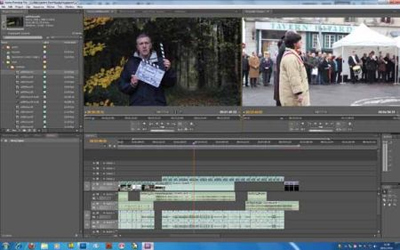articles/Cameras/takingadvantageofdslrvideo-page2
Taking advantage of DSLR Video - part 2 of 1 2 3 4
by Stuart Barry Published 01/12/2010

A 7" external monitor will allow you to focus with ease - not an easy job if you just use the camera's monitor. You may ask why not just let the camera do the focusing? Well, it's back to the old days I am afraid. You will have to get used to manual focusing, which is what the big boys in the film industry do all the time. Of course, if your subject never moves forwards or backwards you could first auto focus on the subject and then start rolling.
But for everything else you will need to turn the manual focus ring, and viewing the scene through a large monitor helps you get it spot on. (Note: auto focus is appearing, but professional film makers still use manual focus.)
If you are recording anything other than ambient sound you will definitely need an external microphone. The in-built microphone of a camera is as good as useless.
Set-up and shoot
Now you are ready to go and just need to set your camera into the correct mode.
The file format often used by DSLRs is .mov (QuickTime) movie format. The frames of the movie are essentially a series of jpg images. As such, you can set any camera style that you like for recording and displaying in the monitor. To start with it is best to keep to a neutral or faithful style. You can always change the style in post production.
Next, you must decide on image size. You generally have three choices:
Full HD. The pixel size is 1920 wide by 1080 high (1080p). For the UK the default is PAL at 25 frames per second (fps). Use this if you want to output to Blu-Ray for HD viewing. You can, of course, use this for everything and just transcode to other formats and sizes later. But be aware that full HD uses a lot of space and you will need a highspecification computer to edit.
HD. The pixel size is 1280 x 720 (720p). This is higher than a standard DVD specification, so good enough for HD-ready TV.
SD (standard definition). The pixel size is 640 x 480. This might seem incredibly small when comparing to still images, but is good enough for DVD and web output, and is much faster to edit. This is a good place to start just to try out some ideas, and might be the size available if you have only basic editing software - see below.
Nearly every video we see today is in widescreen format with an aspect ratio of 16 (units wide) to 9 (units high), usually written as 16:9. SD has an aspect ration of 4:3. So if you want to keep to widescreen you should choose one of the HD modes.
For your first project you could try anything, but subjects that do not jump around too much will build your confidence faster. A tour round your garden and interesting views of your house or street are both possible starters.
Please Note:
There is more than one page for this Article.
You are currently on page 2
- Taking advantage of DSLR Video page 1
- Taking advantage of DSLR Video page 2
- Taking advantage of DSLR Video page 3
- Taking advantage of DSLR Video page 4
1st Published 01/12/2010
last update 09/12/2022 14:59:31
More Cameras Articles
There are 8 days to get ready for The Society of Photographers Convention and Trade Show at The Novotel London West, Hammersmith ...
which starts on Wednesday 14th January 2026





